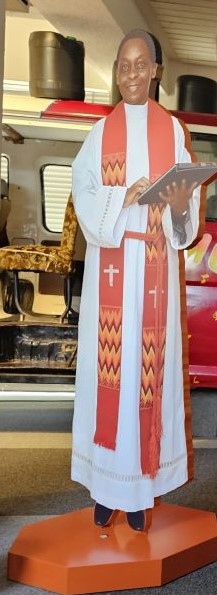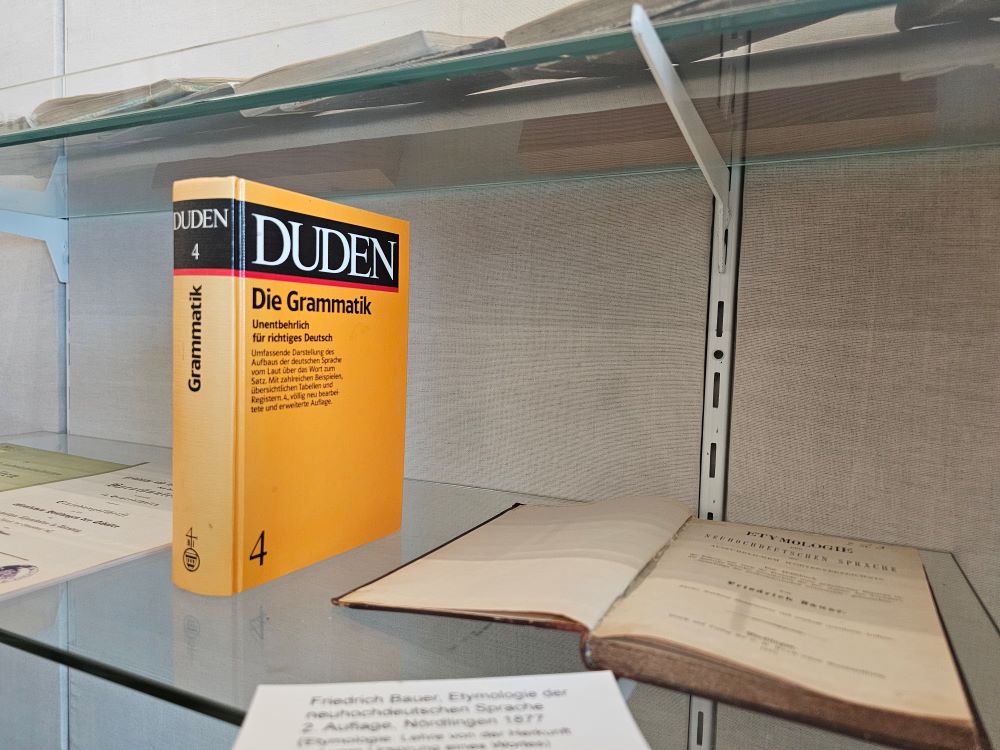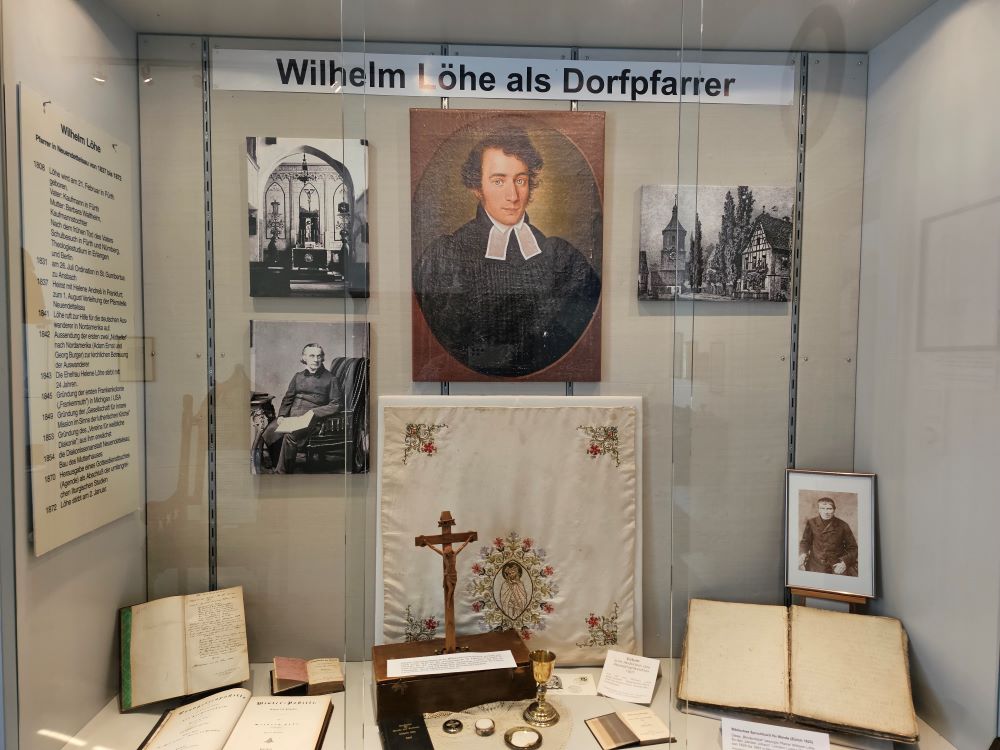Mission EineWelt (One World Mission) is the centre for partnership, development, and mission of the Evangelical Lutheran Church in Bavaria. It conducts “mission” activities both within and outside Germany.
I put “mission” in parentheses because it’s not just about proclaiming the gospel. It’s about apprehending God’s goals for the world, the current state of the world, and how to navigate and move towards the goals.
The goals are achieved through “diaconal” activities which includes serving the poor, disabled and otherwise marginalized, and through learning, teaching, and campaigning.
The Mission EineWelt centre is in the village of Neuendettelsau because it’s where Wilhelm Loehe (1808-1872) began the overseas mission work of Lutherans: he trained and sent pastors and missionaries to North America, Australia, New Guinea, Brazil, and the Ukraine.
The centre includes an exhibition called Exhibition EinBlick, which is renewed at regular intervals. Today, we were given a tour of the exhibition by one of its staff – who told us she’s a trained anthropologist.
The tour began with viewing of a large wall map which showed all the locations at which Mission EineWelt is a partner in activities. Malaysia is included, for work with Orang Asli (Indigenous people).
We asked why Missouri, USA, is not indicated, since the Missouri Synod of that Lutheran Church traces its ancestry to Wilhelm Loehe. Our curiosity grew when the response we got was that this would be explained during our visit to the next museum on our agenda today.
Exhibition EinBlick includes displays for South America, Africa, and Asia. It challenges visitors to think about the impact of human decisions, and actions we can take to recover waste and establish equity.
For instance, we were invited to consider that our cell phones can vibrate when calls are received thanks to use of a rare mineral (earth). Rare earths are called by that name because they occur in very low concentrations. To obtain them, you have to dig up vast areas of land.
Is the vibration feature essential for phones? Should we ravage the earth in order to make the feature available? Should there, instead, be laws to prevent their use?
We were also invited to consider the mass, mechanized production, and sale at low prices, of soyabean crops in Brazil, to feed massive pig farms in Germany. Pigs are fed the soyabean for six months before they are slaughtered. Is that good stewardship of natural resources?

We were shown a cut out of Lutheran pastor Rev Margaret Obaga. As a pastor in the Kenya Evangelical Lutheran Church, she established an extensive diaconal service. Her work drew the attention of the Prime Minister. He offered her the job of a government minister. She accepted.
Though all the explanatory text in Exhibition Einblick is in German, we noticed something surprising: no scripture verses were on display. What makes the EinBlick Exhibition distinctively Christian, let alone Lutheran?
The tour ended in the gift shop, which includes many items from Papua New Guinea (PNG), which has been a field of activity for Mission EineWelt for over a century. The centre is peppered with items such as crosses and carvings produced in PNG.
In the afternoon we visited the Loehe Era (Zeit) Museum. It’s so-named because it’s devoted not solely to Wilhelm Loehe – without whose activities there, Neuendettelsau would’ve been still a tiny village. It’s a museum which depicts daily life in the times in which Loehe lived.
Loehe was a man with a vision for spreading the gospel in the world, through word and works. He never travelled out of Germany, but he sent workers out – and they established many Lutheran communities abroad.
Professor Vorlander, a former director of Mission EineWelt explained that those who went to the USA developed a “democratic” frame of mind, while Loehe adhered to a hierarchical view of social organization. The result was a parting of the ways.
Disappointed with the turn of events in the USA, Loehe turned his attention to diaconal work in Germany.
He raised up a large number of deaconesses – women who took a vow of chastity, lived together, and served the needs of the marginalized. (Their chastity was for practical reasons, not for gaining merit with God.) And he educated them – at a time when women weren’t allowed to study.
Loehe and his close associates funded the work by publishing books and by starting businesses, including construction and the manufacture of bricks. Loehe brought in master craftsmen to establish the industries, using locally available materials. This allowed for building at lower cost, created jobs and gave dignity to workers.

One member of Loehe’s inner circle was a man called Friedrich Bauer. He taught German at a technical school in Nuremberg. To aid his teaching, he wrote a book of German Grammar, had it published in 1860, and together with a colleague, continued updating it till his death in 1874.
Konrad Alexander Duden (1828-1911) revised it and kept updating it till his own death. To this day, this book is continuously revised and remains in publication. Called “Duden,” it’s the go-to reference for German grammar.
The lesson of the day was delivered first through a presentation about Mission EinWelt by one of its directors, Hanns Hoerschelmann, then a tour of Exhibition EinBlick, followed by a tour of the Loehe era museum.
The lesson is, mission is service to others (diaconal) as well as proclaiming Christ and mission is discerning God’s goals for the world and working together with others to achieve the goals, through fund-raising and working with others.
There was some discussion with the Mission EineWelt director about the source of funds for the churches.
We learned that the tax department in Germany gives every taxpayer the opportunity to declare his/her faith allegiance and if he or she chooses, e.g. Lutheran, Catholic, etc., the tax assessment will be inflated by 8 per cent and the money collected will be given to the institution to which allegiance was declared.
Those who don’t declare allegiance to the recognized faith institutions will not be charged the 8 percent “church tax.”
According to a new story published in DW in 2004, the total tax distributed between Catholics and Lutherans in 2000 was about 55 billion Ringgit (yes, “b;” conversion done using today’s exchange rate), and dropped to 42.5 billion Ringgit in 2003 (yes, 20 years ago). Also, the story says “432,000 Germans took their names off church registers between 2001 and 2002” and 1.3 million people worked for the two churches, making them Germany’s largest non-state employer.
How should we represent the relationship between the Lutheran church and the government? Is the state performing a collection service for the church or is the church joined at the hip with the government?
Notes: 1. DW is Germany’s equivalent of the UK’s BBC and Malaysia’s RTM. 2. Catholics and Lutherans each had about 26 million registered members. 3. The churches have to spend extensively to keep ancient buildings in good repair. 4. This website lists other faith institutions on whose behalf the state collects “church tax;” Buddhists, Hindus, and Muslims are not included. 5. According to this website, the rate is 8% in 2 states and 9% in the other 14 states.
To learn more about Rama, click here.



Pingback: Goodness and darkness in Neuendettelsau – Bangsar Lutheran Church